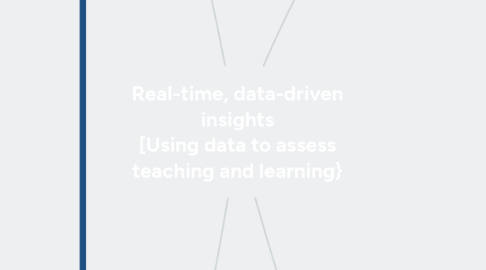
1. What to assess
1.1. Problem solving skills
1.1.1. Peer review activities
1.2. Collaborative skills
1.2.1. Small group activities
1.3. Critical thinking
1.3.1. Reflection activities
1.3.2. Peer review activities
1.4. Creativity
1.4.1. Digital story telling activities
1.5. Procedural skills
1.6. Duration students retain particular information
1.7. Educational materials that produce the best concept mastery
1.8. Information and technology litteracy
1.9. Self Reliance
2. Who will use the data?
2.1. Educators
2.1.1. For better lesson planning
2.1.2. Evaluating effectiveness of teaching methods
2.1.3. Identify students' need
2.1.4. Identify areas that need improvement
2.1.5. Get a better insight on learners's interest
2.1.6. Keep track of engagement and achievement level of learners.
2.2. Learners
2.2.1. To identify their weaknesses and strenghs
2.2.2. To keep a record of their performance
2.2.3. To keep abreast with their progress
2.2.4. To keep control over their learning
2.3. Stakeholders
2.3.1. Parents
2.3.1.1. To monitor their children's academic and holistic developement at school
2.3.2. Teacher unions
2.3.3. School administration
2.3.3.1. To monitor school progress
2.3.3.2. For Better alignment of curriculum across departments and grades
2.3.4. Assessment developers
2.3.4.1. MES & MIE
2.3.4.1.1. To set new , adapted methods of assessments
2.3.4.1.2. To identify gaps in curriculum coverage
2.3.5. Policy Makers
2.3.6. Ministry of Education
2.3.6.1. To devise new means of assessments
2.3.6.2. To get an overview on the effectiveness of the actual education system
2.3.6.3. For the implementation of new education policies and plans
3. Why to assess?
3.1. To Improve academic and administrative performance
3.2. To measure student performance
3.3. To provide effective feedback
3.4. To transform classroom
3.5. To see how differrent schools are performing
3.6. To help students focus on what they want to do.
3.7. To help students master concepts at their own speed
3.8. To increase success rate
3.9. To create self-motivation
3.10. To empower educators
3.11. For better future planning
4. How is data collected
4.1. Formative data
4.1.1. Mini quiz
4.1.2. Quick Thumbs up
4.1.3. Google surveys
4.1.4. WebQuest
4.1.5. Answer drills
4.1.6. Clickers
4.1.7. Exit tickets
4.2. Observational data
4.2.1. Reaction
4.2.2. Participation
4.2.2.1. Response rate
4.2.2.2. Deadlines
4.3. Summative data
4.3.1. Standardized tests
4.3.2. Key-milestone exams
4.3.3. Project work
4.4. Intelligent Tutoring Systems
4.5. Personalised learning plan tool
4.6. Online learning platforms
4.7. Sample assessment tools
4.8. Student reported data
4.8.1. Fun projects
4.8.2. Bar charts to color
